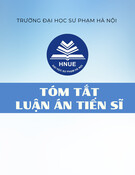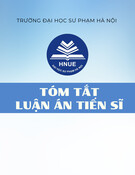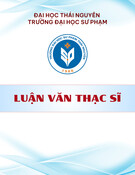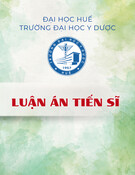VIETNAM ACADEMY OF SOCIAL SCIENCES
GRADUATE ACADEMY OF SOCIAL SCIENCES
----------------
TRUONG THUY HANG
GENDER DIFFERENCE IN CAREER ORIENTATION OF
HIGH SCHOOL STUDENTS AND INFLUENCING FACTORS
(Case study in Tu Son town, Bac Ninh province)
SUMMARY OF SOCIOLOGY PhD THESIS
HANOI 2021
The thesis is completed at:
Graduate Academy of social Sciences, Vietnam Academy of Social sciences
Supervisor:
1. GS. TS. Trinh Duy Luan
2. TS. Dương Kim Anh
Reviewer 1: GS.TS, Nguyen Huu Minh
Reviewer 2: GS.TS. Le Ngoc Hung
Reviewer 3: PGS.TS. Nguyen Thi Kim Hoa
The thesis will be defended in the Institute-level thesis committee, meeting at: Graduate academy of social Sciences, Vietnam academy of social sciences
INTRODUCTION
1. Rationale of the Research
In the process of gender socialization, in terms of career, the
gender difference in career orientation is the difference between men
and women in their career orientation. This process does not stop at high
school level. This is a process that brings an important milestone, with
many expectations of oneself, family and society.
Is there any difference between male and female high school students
in career orientation? What factors influence these differences? These are
questions that previous studies have not yet provided satisfactory answers. With
the topic “Gender differences in career orientations of high school students
and their influencing factors”, this thesis provides useful information based on
theoretical perspectives and practical evidence on this topic. Thereby, it can
contribute to maximizing the potential of high school students in the future
without being hindered by gender stereotypes in career choices.
2. Objectives of the research
2.1. General objective
Point out gender differences in career orientations of high school students
and their influencing factors. From the research result, some recommendations
are given to best promote their career orientation, maximize the potentials and
strengths of male and female students, based on gender differences.
2.2. Specific objectives
1) Build and clarify the theoretical basis of gender differences in career
orientation of high school students, including: gender concepts, gender
differences, career orientation and related theoretical approaches;
2) Clarify the student's career orientation in the current context; point out
gender differences in career orientation of high school students;
1
3) Analyze and point out factors affecting gender differences in career
orientation of high school students;
4) Make recommendations to help them better promote career orientation
in the future, promote the best of their potential.
3. Question(s) of the research
1) How is the situation about career orientation of high school
students? What is the gender difference in career orientation of high
school students in the current context?
2) What factors affect gender differences in career orientation of
high school students?
3) How to best promote their career orientation based on these
differences?
4. Hypothesis of the research
1) Gender differences in career orientations of high school students are
evident in some typical career groups that male or female students choose.
2) Individuals (cognitive factors), family, media and friends are the basic
groups of factors that affect gender differences in the career orientation of high
school students (personal factors influence biggest). 5. Object and subject of the research 5.1. Object of the research
Gender difference in career orientation of high school students; Factors affecting gender differences in career orientation of high school students. 5.2. Subject of the research
1) Male and female students are divided into two groups: grade 11
students and groups of students in grade 12;
2) Teachers are teaching grades 11 and 12; 3) Parents of students in grades 11 and 12;
2
4) Staff of Department of Education and Training, Department of
Labor, Invalids and Social Affairs;
5) Gender specialist in the field of education and employment; 6) Career Specialist. 6. Scope of the research
1) Study at 02 high schools (in which 01 school belongs to the central
ward and 01 school in the peri-urban commune) in small urban areas: Tu Son town, Bac Ninh province;
2) The topic is only directed to research on career orientation of high
school students (grades 11-12) in the survey period.
3) Implementation time: Research conducted in 03 years. From April
2017 to April 2020 7. Research Methodology
The research used a combination of quantitative and qualitative methods, with specific methods as follows: 1) overview, analysis of documents; 2) Method of interview by questionnaire; 3) Method of in-depth interviews; 4) Methods of data processing 8. Sample selection method and fieldwork process 9. Variables and analysis scheme
The relationship between the three groups of variables is depicted
in the Analytical framework (Figure below).
3
SCHEMATIC ANALYSIS
SOCIO-ECONOMIC
CONTEXT
- Industrialization,
SOCIAL IMPACT
- Positive
modernization
- Negative - The situation
- Market economy IA - Globalization and
international integration
- Convention, international law
- Vietnamese policies and
Policy
directions
orientation and
- The media
solution
- Traditional culture
- Students themselves
- Social groups (family, school,
GENDER DIFFERENCE IN CAREER ORIENTATION OF HIGH SCHOOL STUDENTS - Occupational awareness - Attitude towards career - Career choice behavior - The reason for choosing a career
friends) - Other
Note:
Direction to show the impact of socio-economic context
on gender differences in career orientation of high school students and
its consequences.
Direction to show the impact of macro factors to micro
and from social impacts to policy direction and solutions.
Direction to show the opposite impact of gender
differences in career orientation of high school students on
socio-economic context
4
10. Sample size
The total qualitative samples are 32 cases
The total quantitative samples are 706 cases.
11. Research Ethics
Honesty in research and use of research results.
12. New scientific contributions of the Thesis
Thesis contributes new knowledge to struture careers by gender.
13. The theoretical and practical significance of the Thesis
13.1. Theoretical significance
- Contribute to clarify the content of the concepts;
- Contribute to assert more theoretical value, popularity and
usefulness of the theory for real life;
- Is a useful reference for the next research.
13.2. Practical significance
The thesis contributes to helping young people better orient their
careers in the current context, and reduce gender barriers.
12. Structure of the thesis
The structure of the thesis includes the following sections: Table of
contents, List of tables; Introduction; Chapter 1, Chapter 2, Chapter 3,
Chapter 4, ConclusionReferences and Appendix.
CHAPTER 1. OVERVIEW OF RESEARCH
To have an overview of the research topic and find out gaps in
perceptions or issues that need to study, it is necessary to review the
situation of domestic and foreign studies on the topic of gender
difference in the career orientation of young people and students today.
The research overview will be deployed according to 03 main groups of
issues: 1) Identify career-oriented concepts and the role of career
orientation; 2) The status of career orientation and gender differences in
5
the career orientation of students in recent years; 3) Factors affecting the
gender differences in career orientation of high school students.
1.1. Career orientation and the role of career selection
Career orientation and the role of job selection are reviewed based on
two groups of issues as follows: 1) Some concepts of career orientation; 2)
The role of career orientation and career selection
1.2. Current status of career orientation and gender differences in
career orientations of high school students today
The issue groups reviewed: 1) Current situation of career orientation; 2)
Confusion, difficulty and lack of understanding about the profession; 3) The
careers students choose to prioritize; 4) Factors of interest in the student's career
orientation; and 5) Gender differences in the student's career choices
1.3. Factors affecting gender differences in career orientation of
high school students
1.3.1. Factors that influence a student's career orientation
Studies have shown a number of basic groups of factors that
influence a student's career orientation: individual students, family,
friends and teachers, the school's career guidance, and mass media.
1.3.2. Factors affect gender differences in orientation and career
choices of students
Two major factors affecting showed gender differences in career
choices of students indicated that gender in the labor market and gender
stereotypes, gender stereotypes in career choice.
Studies also show that there are factors that affect the career
orientation of students, including factors create gender differences, but
have not been fully studied in depth. It is necessary to have in-depth and
thorough research to provide theoretical and practical bases to explain
gender factors in career orientation of high school students.
6
CHAPTER 2: THEORETICAL AND PRACTICAL BASIS OF THE
THESIS
This chapter focuses on analyzing two main contents: theoretical basis
and practical basis of the thesis. Along with the overview, this is the
theoretical and practical basis for the implementation of the thesis.
2.1. Some basic concepts
2.1.1. Basic concepts related to gender
Some basic concepts related to gender are clarified, including: Gender and Sex; Gender socialization; Gender stereotypes; Gender biases; Gender discrimination; Gender gap; Gender difference. 2.1.2. Career orientation of high school students
Some clarified concepts related to the career orientation of high school students are: Orientation; Occupation / occupation; Career orientation. 2.1.3. Gender differences in career orientations of high school students
Shown on the following basic aspects: 1) Gender differences in perceptions of students about career conformity by gender, about the appropriateness of some occupational characteristics by gender;
2 Gender differences in career-related behaviors before making a decision to choose a career (choice of grade to study; intention to choose education level);
3) Gender differences in the student's intended future career choice
behavior (present decision-making);
4) Gender differences in the reasons for planning to choose a career
in the future. 2.2. Theories used in research
The thesis uses the gender difference theory to explain gender differences in the career choices of students; Reasonable choice theory
7
helps explain students' career choice actions. The theory of socialization, especially gender socialization will help explain the factors that influence the difference in career orientation of students. 2.3. Relevant legal documents and policies 2.3.1. Some policies related to career orientation
- United Nations International Convention on the Rights of the
Child (1989)
- Labor Code (2012); - CEDAW Convention (1979).
2.3.2. The legal text the main provisions on gender equality, gender mainstreaming in the field of education and training
- Agenda 2030 for Sustainable Development of the United Nations
(2015); Law on Gender Equality (2006);
- National Strategy on Gender Equality for the period 2011 - 2020; - Law on Education and Education Development Strategy 2011 -
2020;
- Decree No. 48/2009 / ND-CP dated September 15, 2009 on
measures to ensure gender equality.
2.4 . Introduction to the research area
In this part, the thesis introduces about Tu Son town, Bac Ninh
province and 02 high schools: Ly Thai To and Ngo Gia Tu.
8
CHAPTER 3: THE CURRENT SITUATION OF GENDER
DEFORMATION IN THE CAREER ORIENTATION OF HIGH
SCHOOL STUDENTS
This chapter describes the current situation of and gender differences in
career orientation of high school students. Based on the concepts explained in
Chapter 2, the thesis focuses on analyzing the current situation of four aspects
related to gender differences in career orientation of high school students.
3.1. Gender differences in perceptions of job suitability, some characteristics
of the profession by gender of high school students
3.1.1. Career perceptions are appropriate for boys and girls of high school
students
Occupations / groups of occupations
Suitable for both gender
Suitable for both gender
Most young people have a perception that the occupations they choose are suitable for both sexes, men can do it, and women can also do it. However, gender stereotypes, Gender bias about their profession are still evident in some occupations such as police / officer / military, programmer / information technology, engineer (construction, machine builders, and electronics) and pilots. None of the youth surveyed thought that these occupations were more suitable for women. 3.1.2. Gender differences in career awareness suitable for men and women of high school students Table 3.2. Perception of job relevance by gender of male and female students (%) Male (M=269) More suitable for female 28,0 Female (F=358) More suitable for female 8,3
More suitable for female 16,7
More suitable for female 0,0
75,0
72,0
0,0
27,3
72,7
69,6
30,4
0,0
0,0
100
0,0
52,8
44,4
2,8
50,0
0,0
50,0
0,0
100,0
0,0
1. Doctor / pharmacist 2. Police / officer /
military 3. Programmer / IT 4. Teacher
9
Occupations / groups of occupations
Suitable for both gender
Suitable for both gender
Female (F=358) More suitable for female
More suitable for female
Male (M=269) More suitable for female
More suitable for female
5. Art activities (actors, singers 20,0 40,0 40,0 0,0 14,3 85,7 ..) 34,9 2,3 62,8 16,7 0,0 83,3
11,1 33,3 55,6 23,1 76,9 0,0
0,0 45,5 54,5 64,3 35,7 0,0
30,8 0,0 69,2 0,0 100,0 0,0
0,0 35,7 0,0 11,4 9,1 14,3 17,9 12,5 0,0 0,0 0,0 4,5 0,0 14,3 4,5 0,0 0,0 64,3 100,0 84,1 90,9 71,4 77,6 87,5 60,0 0,0 0,0 0,0 50,0 25,0 21,6 0,0 40,0 100,0 100,0 100,0 50,0 75,0 78,4 100,0 0,0 0,0 0,0 0,0 0,0 0,0 0,0 0,0
0,0 0,0 100,0 0,0 0,0 100,0
3,3 0,0 33,3 0,0 0,0 11,1 96,7 100,0 55,6 30,0 0,0 40,0 70,0 100,0 60,0 0,0 0,0 0,0 6. Auditor / accountant 7. Architect / graphic design, art 8. Egineer 9. Beauty (nail, hair, make- up) 10. Pilot 11. Flight attendants 12. Tour guide 13. Translator 14. Journalist/writer 15. Banker 16. Business/marketting 17. Lawyer 18. Streammer, Vlogger, youtuber.. 19. CEO/Businessmen 20. Servant/Office staff 21. Worker/Chef/Carpentr y
(Source: Survey data in Tu Son town, Bac Ninh province)
There are 13/20 occupations with differences in perceptions of male and
female students on the suitability of occupations with gender, and 7/20 occupations
don’t have this difference. It is obvious that, stereotypes, prejudices about gender
careers exist in female students is much higher than male students.
10
3.1.3. Perception of the job characteristics that are appropriate for
men and women of high school students
It can be seen that gender stereotypes, especially gender
stereotypes about career scores still exist in a certain part of high school
students through analyzing whether students evaluate occupational
characteristics suitable for men or women or both.
3.1.4. Gender differences in the perception of job characteristics
suitable for male and female of high school students
Female students have a much higher perception of stereotypes and
stereotyped career appropriateness with gender than men
Table 3.4. Perception of gender-suitability job characteristics of male and female students
(Percentage %)
Female (F=390) Male (M=314)
P- Value Occupational characteristics (Total=706)
More suitab le for male
Suitab le for both gender
More suitab le for male
Suitab le for both gender
More suitab le for femal e
More suitab le for femal e
<0.05 35,1 0,3 64,6 34,4 2,2 63,4
56,2 0,8 43,1 42,7 5,1 52,2
2,6 8,7 88,7 3,2 20,4 76,4
1,8 11,3 86,9 0,6 22,0 77,4
of <0.00 1 <0.00 1 <0.00 1 <0.05 0,8 19,0 80,3 1,6 27,7 70,7
to 1,0 67,4 31,5 1,0 51,3 47,8 1. Helping/taking care of others 2. Careful/metico lus 3. Communicate with people 4. Earning lots of money 5. Capable promotion 6. Related technology <0.00 1
11
of >0.05 1,3 61,3 37,4 1,0 58,9 40,1
4,6 14,1 81,3 2,9 30,6 66,6
<0.00 1 <0.00 1 3,1 19,7 77,2 1,6 42,0 56,4
<0.01 9,7 7,4 82,8 11,5 15,9 72,6
>0.05 a to study 3,1 9,2 87,7 5,1 12,7 82,2
>0.05 15,1 13,1 71,8 12,1 13,4 74,5 7. Lots business trips 8. Requires creativity 9. Requires strong, assertive, confident personality 10. Have a change to work part-time 11. Have change higher 12. Allows flexible hours
(Source: Survey data in Tu Son town, Bac Ninh Province)
Gender differences in the concept of gender-appropriate job
characteristics show that each gender tends to evaluate their traditional
gender roles more clearly than the rest.
3.2. Gender differences in career-related behavior prior to making
career choice decisions for high school students
3.2.1. Orientation of majors to study of high school students
Natural science is chosen by students more than the social sciences. The
combination of natural, social and foreign language subjects is also a trend chosen by
many students. With P <0.001 test results, it can be said that students with good
academic performance tend to choose the blocks which are considered to be more
difficult and more natural science.
12
60
46.2
39.2
40
27.4
22.9
Nữ
17.2
20
10.5
9.2
Nam
7.2
6.4
3.1
0
A
A1
B
C
D
Gender analysis of majors of high school students shows that the gender difference is statistically significant (P <0.001). Male and female students have differences in choice of majors according to natural sciences, natural sciences
combined with social sciences.
With block C, in pure social sciences, male have slightly more choices than female
Table 3.1. The choice of majors to study for male and female students
(Percentage)
(Source: Survey data in Tu Son town, Bac Ninh Province)
The gender difference in the choice of majors also illustrates the situation of careers in the labor market. That picture still seems familiar. Female is the majority of graduates of education, humanities and health, while the majority of male graduates in the fields of engineering and architecture (Luca Flabbi, 2011; Maaike van der Vleuten et al. , 2016). 3.2.2. Orientation by education level (intermediate, college, university ...) of high school students
Majority of students choose to continue on to college. In fact, college is not the only way to career success. With the remaining 23.7% of students not oriented to university, it is a minority compared to the group with university orientation, but this can be considered as a good sign of diversification and change in perception of society (students and their parents)
13
3.2.3. Gender differences in the orientation by education level (intermediate, college, university ...) of high school students
Regarding the intention to stop going to school, finding jobs right away, the ratio of male and female students is the same. The proportion of male students who plan to stop going to school has jobs and higher secondary education than women. On the contrary, female students' intention to choose to go to college or university is higher than that of men. 3.3. Gender differences in the future career-selection behaviors of high school students 3.3.1. Intended future career choices of high school students
Table 3.6. Intended to select students' future careers
Number Percentage Occupation / job
118 50 16,7 7,1 1. Business/marketting 2. CEO/Businessmen
3. Doctor/Pharmacist 4. Auditor/Accountant 49 49 6,9 6,9
5. Translator 6. Programmer / IT 49 39 6,9 5,5
39 5,5 7. Engineers (construction, machinery, electronics)
8. Teacher 9. Police / officer / military 35 34 5,0 4,8
10. Architect / graphic design, art 11. Workers / chef / carpentry 22 19 3,1 2,7
12. Flight attendant 13. Servants / office workers 14. Tour guide 15. Beauty (nail, hair, make-up) 16. Journalist / writer 17 16 15 14 13 2,4 2,3 2,1 2,0 1,8
14
Occupation / job Number Percentage
17. Art activities (actors, singers ..) 12 1,7
18. Banker 19. Lawyer 11 11 1,6 1,6
20. Streammer, Vlogger, youtuber... 21. Pilot 10 5 1,4 0,7
22. Unknow 23. Others 71 8 10,1 1,1
706 100,0 Total
(Source: Survey data in Tu Son town, Bac Ninh Province)
It can be seen that students' intention to choose careers is quite diverse. The
occupations that are intended to choose include traditional occupations, modern occupations
and jobs that have recently appeared in society. The results also show that students from two
high schools mainly intend to choose jobs with the nature of "teacher" rather than "worker".
3.3.2. Gender differences in career choice behaviors of high school
student
To have the focus to analysis and capacity of the stool samples have sufficient
statistical significance, we grouped, collapsed from 21 jobs and occupations (table above)
into 06 basic occupation groups and analyze gender differences based on these groups.
3
Group of police/officer, military
8.4
23.5
Group of culture, arts and tourism
7.7
Female
40.7
Group of business, market
29.6
Male
6.6
Group of IT, Engineering
32.2
0
10
20
30
40
50
Table 3.4. Male and female students' intention to choose careers (%)
The data show that there is a statistically significant difference
15
between male and female students in the trend of choosing a career for
the future in some of the following occupational groups.
In general, young males tend to choose occupations of complex
nature, requiring high technical expertise, health / physical well. These are
natural sciences professions. While young females tend to choose soothing
light and less complex profession. These are jobs that fall into the category of
social sciences or have a combination between the social sciences and the
natural sciences
3.4. Gender differences in reasons for intended career choice in the
future of high school students
Research results show that, the four biggest reasons students agree when choosing a
career are: 1) This is their favorite career; 2) Steady work; 3) Match the ability; 4) High
income. The average score (a 5-level scale) of these factors is at 4 and above 4. The next four
reasons are close to 4, the second group of reasons students care: 1) Have a good condition.
family squirrel; 2) Having a reputation that is highly appreciated by society; 3) Suitable for
health; 4) Easy to find jobs.
When considering the opinions of students by gender, the data show
that the reasons for choosing a career between male and female are almost
no difference, or there is no significant difference (difference from 0.01 to
0.23 average points).
CHAPTER 4: FACTORS AFFECTING GENDER
DIFFERENCE IN THE CAREER ORIENTATION OF HIGH
SCHOOL STUDENTS
This chapter focuses on analyzing and clarifying the factors that affect
gender differences in career orientations of high school students. Logistic
regression model to indicate which factors have the most important
16
influence on gender differences in career orientation of high school students
in the study area.
4.1. Advice/sharing of family about careers
4.1.1. The level of interest of high school students in
advice/sharing of family about the students' future careers
The results show that in the process of career orientation and
selection, students show the most attention to the advice / sharing of their
parents (especially the mother), following by the advice of siblings, aunts,
uncles and grandparents. Approximately one third and more than one third
of students in the study showed a lot and a lot of interest in the advice of
their parents. It means the closest relatives in the family can more or less
influence a student's career choice orientation
4.1.2. Gender differences in the level of interest in advice / sharing
about the careers of high school students' families
Female students tend to care (listen, consult) more than male
students about career advice / sharing of all family members (except for
other relatives), but the difference is almost negligible and almost no
statistical significance. The only difference between male students and
female students in listening to their mother's advice / sharing about
careers is statistically significant (P <0.01). Accordingly, female is more
likely to listen to advice / sharing about careers of both parents than
male.
4.2. Career-oriented activities from the school
4.2.1. High school students' level of interest in a number of school
career-related activities
The results show that although the school's career guidance is
valued, in reality, students do not pay much attention. That partly explains
the role of this activity for students.
17
4.2.2. Gender differences in student interest in school career-related
activities
The percentage of female students interested in most of the
school's career-related activities was slightly higher than that of male
students and there was no statistically significant difference. There is
only one activity: talks and job sharing from employers and education
experts are statistically significant differences (P <0.01) between male
and female in the level of interest. Accordingly, women tend to pay
more attention to this activity than men.
4.3. Advice / sharing from teachers about careers
4.3.1. The student's level of interest in advice / sharing from teachers
about careers
The results of the thesis show that the percentage of students who are
interested in teachers' career advice / sharing is the majority with over 70%.
However, the level of interest is mainly concentrated at the slightly
interested level, with the average point around 3 (on a 5-level scale). The
rate of interest is much and much more at a more modest level
4.3.2. The student's level of interest in advice / sharing from teachers
about career of high school students
There is a statistically significant difference in the level of
interest between male and female students about advice/ sharing and
teachers' career image (P <0.05). Results showed that female more
attention to advice / share of teachers than male. In particular, the
percentage of female is much more interested in the image of teachers
than male.
18
4.4. Advice / sharing from friends about careers
4.4.1. The level of interest of students to advice / share of friends
The percentage of students with attention to the advice of friends
higher than students who are not interested (above 50%). However, the
difference is negligible. Students mostly stop at the level of interest a
little bit, with approximately average points. Students mainly interested
in the advice / sharing of classmates, or with friends of other class but
same gender
4.4.2. The level of interest of students to advice / share of friends about
career There is a statistically significant difference in the interest level of male and female students about advice / share of friends about career. The results show that the proportion of female people interested in the
advice/ sharing of their friends more than that of male. However,
considering the level of interest, female is mainly interested in a little bit
and more than men. With a lot of interest in the advice / sharing of
friends, the male is much higher than female.
4.5. Mass media about career
4.5.1. Student's level of interest in career-related aspects in the mass
media
The only factor related to media is career image of idols on the
internet is not a factor students are interested in related to career. Thus,
although the media, especially the internet is increasingly important for
young people, the information on career image above is not a factor that
attracts much attention from students.
19
4.5.2. Gender differences in student interest in career-related aspects
in the media
There is a statistically significant difference in the level of
interest of male and female students in career images on all mass media
(P <0.05). The results show that, compared to male students, female
students have more attention to information and images of careers in
most media.
4.6. Assessment of student about the influence of family, school,
friends and the media to their career orientation
4.6.1. Assessment of student about the most influential factor to their
intended career choice
48.6
37.7
9.7
2.2
0.7
60 40 20 0
Results of student assessment is shown in the following chart.
Table 4.1 Evaluate the factors influencing a student's intention to
choose a career (%)
(Source: Survey data in Tu Son town, Bac Ninh Province, N = 706)
Nearly half of students have self-control and a certain righteous
perspective and decide for themselve to choose their future career. In
these factors, students decide by themselves accounted for the majority.
In other words, students assess that the most influential factor in their
career choices is themselves, then is their family.
20
4.6.2. Gender differences in assessment of student about the most
influential factor to their intended career choice
Gender differences in assessment of student about influence
of family on career orientation
In general, female students are influenced by family advice /
sharing more (not significantly) than male students in career choices.
Female students are influenced more than male students from the advice
of their parents, grandparents and siblings. Male students are influenced
more than female students by other family members.
Gender differences in assessment of student about
influence of school, teachers, friends on career orientation
It is noticeable that female thinks that the school's career
orientation influences the intention of choosing a career much higher than
male (more than 2 times). But this difference is not statistically significant.
The research results also show that the percentage of female
who believe that they are influenced by teachers in career orientation is
much higher than that of male (more than 2 times). It means female
thinks she is influenced by teachers more than male. However, this
difference is not statistically significant.
Assessment of student about influence of school, teachers,
friends on career orientation, the percentage of female who think that
friends have an influence on her is higher than that of male.
Gender differences in assessment of student about influence
of mass media on career orientation
Male and female students' assessment of the influence of media
on their own career choices was not significantly different, and not
statistically significant. Even television affects male and female career
choices equally.
21
4.7. Results of inspection of factors affect gender differences in
career orientation of high school students
4.7.1. Male and female students' career choices and motives for selection
The dependent variable of the topic has been identified as:
Career choice of men and women (gender differences). Due to the
limitations of time and and resources, the author selects jobs with
statistically significant gender differences with the rate of choosing this
occupation group over 15% as the dependent variable.
Table 4.11. Career choice of male and female students
Gender P-
Value Male Female Total
Occupation group n % n % n %
1. Group of IT, technical 91 33.2 24 6.6 115 18.1 P<0.001 profession
2. Group of business, market 81 29.6 147 40.7 228 35.9 P<0.01
3. Group of cultural, art and 21 7.7 85 23.5 106 16.7 P<0.001 tourism occupations
4. Group of Social service 42 15.3 69 19.1 111 17.5 P>0,05 profession
(Source: Ssurvey data in Tu Son town, Bac Ninh province).
Among 17 research motives, the motivation of male and female
students to choose jobs is almost the same in all three occupational
groups. Students when choosing these careers tend to focus on 9 basic
motivational groups as follows: High income, social prestige, stable job,
easy to find jobs, suitable for health, suitable for their abilities, suitable
with the family's financial ability, able to take care of the family and
especially, this is my favorite profession.
22
4.7.2. The relationship between academic and career awareness of
students and the career choices of male and female students
We found that well-educated student have the spirit of being
ready to enter the traditionally male dominant field. But it seems that they
are not ready to break all barriers of stereotypes and gender stereotypes
about careers.
Students with occupational awareness and occupational
characteristics containing gender stereotypes choose IT and technical
career groups more than those without gender stereotypes in both men
and women. With two groups of business, market and culture, art,
tourism is the opposite.
Occupational awareness was significantly associated with the
choice of groups for all three occupation groups.
4.7.3. Relationship between families and career choices of male and
female students
It is visible that both male and female students tend to choose
professions with high expertise, away from simple labor, manual labor
like their parents' jobs.
An urban location can be a place where students tend to choose
a career that is more economic or cultural and artistic
4.7.4. Results of multivariate regression analysis
There are 06 logistic regression models analyzed. The
aggregated results show that only a number of factors that affect the
career choice of male and female students are statistically significant.
Specifically:
Occupational awareness affects both men and women in selecting
information technology and engineering occupations. In particular, this
factor only affects men in choosing business groups and markets.
23
Father's education only affects female students in choosing business groups
and markets.
The living area only affects women in choosing a group of cultural, artistic
and tourist occupations.
The remaining factors that do not affect the gender difference in the
selection of these occupational groups are statistically significant.
CONCLUSION AND RECOMMENDATIONS Conclusion
Most students have the opinion of choosing career, career characteristics, regardless of being male or female. However, the gender differences and gender stereotypes still exist.
In the process of career orientation, students are influenced by many different factors, of which they themselves are the most influential factor, then their families. Female students also feel that they are influenced by their parents more than boys.
Logistic regression analysis results once again confirm individual factors, namely, students' perception of careers that affect gender differences in choosing a number of career groups of high school students. Recommendations From the research results, the thesis give some main recommendations
as follows. All levels and sectors, schools, families, and mass media need to join hands to change the gender stereotypes, negative stereotypes relating to the profession. The school also needs to be a place to contribute to eliminate gender stereotypes about careers from students' parents.
It is necessary to continue to raise awareness and knowledge about gender equality in general and gender equality in the career field in particular for generations of students, especially students who are at the threshold of career choices for the future.
24
LIST OF ATICLES OF THE AUTHOR
STT Content Page
76-88 1
The influence of family on career orientation of today's youth (Co-author). Journal of Family and Gender Studies. No. 1/2020
85-94 2
Factors affecting career orientation of high school students. Journal of Human Resources and Social Sciences. No. 2/2020
3 Career orientation of high school students today. 39-45 Journal of Social Science Information. No. 3/2020
260-269 4
The role of parents in their children's career choices, Proceedings of the International Scientific Symposium, 2020: Gender Roles in the Modern Family. Youth Publisher 2020.
104 5
(Abstract)
The article awaiting publication: Fostering sustainable development by eliminating gender stereotypes in career choice (co author). Proceeding of the 1st International Conference on Economics, Development and Sustainability (EDESUS Proceeding 2019) “Global Changes and Sustainable Development in Asian Emerging Market Economies”. Publish by Springer, 2021


























